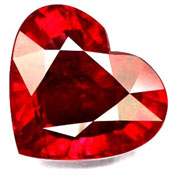Ruby
(roo-bee)
HISTORY and LORE
- Ruby’s age-old status is reflected by one of the Sanskrit names for it – ratnaraj, which translates to “king of precious stones”. A book written in Europe during the 1300s says, “Fine ruby is the lord of all stones. It is the gem of gems, and surpasses all precious stones in virtue.”
- Modern name comes from Latin ruber meaning red. In the past, ruby’s glowing color led people to think an unquenchable fire burns within its heart.
- According to the folklore of ancient India, ruby preserves physical and mental health, prevents evil thoughts, reconciles disputes, and ensures safety. Centuries later, Europeans believed it enables its wearer to live in perfect peace and happiness.
- In finest quality, ruby is among the world’s rarest and costliest gems. At an auction in 1988 a 16-carat ruby sold for more than $227,000 per carat.
- Birthstone for July. Gem for the 15th and 40th wedding anniversaries.
VALUE FACTORS
- Color: Medium to dark red (often slightly orangish, purplish, or pinkish). Most expensive is pure red tat’s deep and incomparable vivid.
- Clarity: Often lightly included. Minor clarity characteristics are accepted.
- Cut: Usually faceted in traditional shapes and styles. Sometimes fashioned into cabochons and beads.
- Carat Weight: Seldom over 5 carats, especially in fine quality.
TREATMENT
Almost all rubies are treated.
- A routine method is heating to improve color or clarity.
- Also common is filling cavities with epoxy resin or glass to improve clarity appearance (this can add weight too).
- Fractures may be filled with oil, epoxy, or glass.
- Permanence and special care: Heat treatment is normally permanent, and creates no special care requirements for gem owners. The same is true of many fillings, but oil eventually deteriorates. Oiled rubies should not be exposed to intense light or even mild heat, such as direct sun, or to solvents or other chemicals.
- When a fine-quality ruby is certified as untreated by a respected trade laboratory, it will usually command a premium price.
GEMOLOGY
- A variety of the mineral species corundum. Other corundum varieties are sapphire, star ruby, and star sapphire. To be considered ruby, the dominant hue must be red, and the overall color at least moderately dark and strong. Otherwise, the material is correctly identified as orange, purple, or pink sapphire.
- Composed primarily of aluminum and oxygen; chemical formula Al2O3. Color caused by trace amounts of chromium. (Chromium also colors emerald. The different colors result from differences in the overall chemistries of the two gems.)
CARE
Ruby generally has very good to excellent wearability.
- Hardness: Very high scratch resistance. Rates 9 on the Mohs Hardness Scale. Next to diamond, ruby and sapphire are the hardest natural gems.
- Toughness: Resistance to chipping and breaking is normally excellent. (Clarity characteristics may affect this.)
- Stability: Usually no routine concerns for gem owners.
- Cleaning: Liquid cleaner, or detergent and water (but no hard scrubbing for oiled gems). Ultrasonic is usually safe, except for rubies with noticeable clarity characteristics, or those that are cavity- or fracture-filled.
